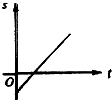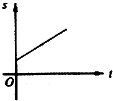问题
选择题
老师在黑板上画出了如图所示的四个运动图象,问同学们这四个图象各表示什么运动?阿杜同学做了如下回答,其中错误的是( )
A.

表示物体先沿负方向做匀减速运动,速度为零后又沿正方向做匀加速运动
B.

表示物体做匀速运动
C.

表示物体做匀减速运动
D.

表示物体做减速运动
答案
A、从图象可知,物体做匀速直线运动.故A错误.
B、位移随时间均匀增大,物体做匀速直线运动.故B正确.
C、从图象可知,物体先向正方向做匀减速直线运动,然后反向做匀加速直线运动.故C错误.
D、位移时间图线的切线斜率表示瞬时速度,从图线斜率可知,速度减小,知物体做减速运动.故D正确.
本题选错误的,故选AC.
